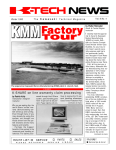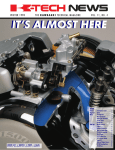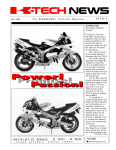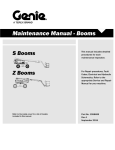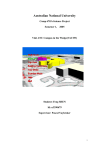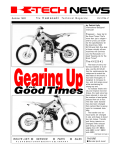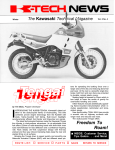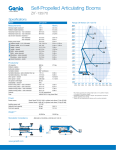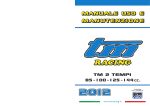Download K-Tech News Vol. 5 No. 4
Transcript
The Kawasaki Winter 1992 by Patrick Kelly Instructional Designer/ Instructor Aerodynamically efficient, fast, powerful, ram air induction-all terms that could be used to describe the latest Air Force fighter jet. But in this case, the terms are being used to describe a fighter of a different sort: Kawasaki’s latest weapon in the fight for top dog status in the sporting middleweight class, the 1993 ZX600-E1. The twin ram air induction system is the biggest ROUTE LIST: o P L E A S E Technical Magazine news on the new ZX600El. The twin ram air system utilizes air intake ducts located just below the headlight to force air into the airbox as the vehicle moves down the road (See the “Technicalities” sidebar on page 2). But, twin ram air induction is not all that is new about the ZX600-E1. The engine itself has been highly refined and the frame and swingarm are all new. Plus, there are a host of other new goodies, too! The goal when upgrading the ZX600 engine was SERVICE R E T U R NT O improved volumetric, combustion and mechanical efficiency, along with lighter components for quicker revving. This goal was achieved by a combination of engine refinements. Starting with the valve train, the valve stem diameters were reduced from 4.5mm down to 4.0mm and the area where the stem joins the head was thinned significantly to allow better air flow through the ports. A significant side effect is that the valves are lighter, 15 percent on the intakes and 19.7 percent on the exhausts. o PARTS S E R V I C E o L I B R A R Y SALES Vol. 5 No. 4 Along with the lighter valves, 35 percent lighter exhaust valve tappets are used. These new tappets are coated with manganese phosphate for faster break-in and improved durability. Because of the lighter valves and tappets, lighter valve springs can be utilized. Lighter valve springs result in improved mechanical efficiency because it takes less power to open the valves, leaving more power to drive the rear wheel. CONTINUED ON PAGE 2 Inside! n Service tips & more! ZX600-E1 CONTlNUED FROM PAGE 1 Along with the new valves and valve springs are new camshafts with increased lift and duration. The intake cam has gone from 280° of duration to 308° and the lift has increased 0.1mm to 8.8mm. The exhaust duration has increased from 280° to 292° while the lift remains unchanged at 8.2mm. These duration numbers are not quite as radical as they might appear at first glance because the cam lobes are designed to open and close the valves relatively slowly for reduced valve train noise and increased durability. Much of the duration is at a small amount of lift. New 13.4 percent lighter slipper-style pistons are used for reduced mechanical friction and reduced reciprocating mass. These new pistons combine with flat valve surfaces (instead of concave) to increase the compression ratio to 12:1 from 11.5:1. New 7.9 percent lighter taperedstyle piston pins connect the rods to the pistons. The lighter pistons and pins allow the use of lighter connecting rods as well, down from 290 grams to 240 grams. The new rods feature big end diameters that are reduced in size from 33mm down to 30mm. Reducing the rods big end diameters causes a large reduction in the amount of drag the journal generates, again improving mechanical efficiency and leaving more power to drive the rear wheel. To go with the lighter top end components, the 2 K-Tech News l crankshaft and flywheel have also been reduced in weight. Providing proof that the engineers left no stone unturned in their search for power, the cylinder liners have been shortened 8.0mm to allow the air to move more freely underneath the pistons, increasing high-rpm power. The exhaust gasses exit the engine through a special 4-into-2-into-1-into-2 exhaust system. This unique system features pipes which connect cylinders 1 and 4 as well as cylinders 2 and 3 to help smooth out the exhaust gas flow, particularly at about 6,000rpm. A revised ignition timing data map completes this new engine package. The end result of all these changes? More horsepower throughout the rpm range. But in case you think Kawasaki would put that wonderful power to waste in a less than state-of-theart chassis, think again! The frame is a new design, constructed of pressed aluminum sheets. These sheets are welded together and then joined to large hollow cast aluminum sections at the steering stem and swingarm pivot. Building a frame this way is more expensive, but the end result is a frame that is not only lighter but stronger as well. Joining the new frame is a new swingarm. The swingarm also uses a hollow cast-aluminum piece at the pivot area. This large cast piece is joined to aluminum extrusions leading back to the rear axle. The result is similar to the frame: lighter and stronger. Lighter and stronger: “E” parts on the right vs. “D” parts on the left (photos clockwise from top left): valves, exhaust tappets, pistons and piston pins. Con rod comparison: “D” part on left, “E” part right. ZX600-E1 New frame combines cast and pressed aluminum. (Above) Ram air intakes below the headlight. (Above, right) A sensational middleweight package. The frame’s geometry was revised as well. The rake remains the same, at 24.5°, but the trail has been increased slightly to 96mm from 95mm and the wheelbase has been shortened considerably from 56.7 in. down to 55.9 in. The front and rear axles have been increased in diameter for increased rigidity to complement the new frame. The brakes have also been updated, with the front brakes featuring thinner discs combined with the same reliable four-piston calipers. The rear brake features a new single-piston caliper and a 10mm larger brake disc. To keep driveline lash to a minimum, a new rear wheel coupling damper is used. This new damper is a unique design with holes located in the damper rubber itself. The holes allow the damper to absorb the rear wheel torque very progressively for lash-free acceleration and deceleration. Surrounding the modern engine and chassis pack- age is a new, aerodynamically designed fairing. This new fairing not only provides increased rider protection from the elements, but also is more aerodynamically efficient. This wonderful new middleweight not only performs, it does so without sacrificing rider comfort and convenience. The riding position is roomy and comfortable, with the handlebars being closer to the seat for a less crouched riding position. And, for convenience, a fuel gauge has been added to accompany the speedometer, tachometer and temperature gauges. There is a new maintenance-free battery so checking electrolyte level is a thing of the past. All this and a centerstand too! The Kawasaki ZX600El, like the latest state-ofthe-art jet fighter, is prepared for take-off— ready to battle the competition, on the race track and the sales floor. Ready to take them on -and equipped to win! o TECHNICALITIES Ram air an efficiency boost! R am air induction uses a sealed intake system with air intakes located in the front of the motorcycle faking. As the vehicle goes down the road, air is forced (or “rammed’) into the airbox. The result? Airbox pressure that is greater than atmospheric pressure even at moderate speed. While it is true that the amount of “boost” above atmospheric pressure is small, it must be remembered that on most motorcycles, the airbox is a restriction to the intake system. Thus, as the engine demands more air, the air-box pressure may drop below atmospheric pressure. The ram air system makes up this difference and more. A side benefit of this system is that not only is the incoming air slightly pressurized, but, since it is drawn from the front of the vehicle, it is relatively cooler and denser than drawn from other locations on the motorcycle. This helps to boost efficiency too. The end result? About 5-7 percent more horsepower at high speed! - Patrick Kelly ZX1100-D1 The Technical Magazine 3 l Winter 1992 Vol. 5 No. 4 ©1992 Kawasaki Motors Corp., U.S.A. (KMC). All rights reserved. K-Tech News Staff Publisher Kawasaki Tech Services Publications Manager Don Church Executive Editor Gary Herzog Editor-in-Chief Gregg Thompson Communications Editor Patrick Kelly Regional Editors North and East Fred DeHart Central and South Walter Rainwater Contributors Randy Davis, Joe Nowocinski, David Pyle, Steve Rice, Mary Sola, Ray St. John Graphics/Production Graphic Art Gregg Thompson Copy Editor Pat Shibata Production Nickless Communications Published by Kawasaki. All suggestions become the property of KMC. Sending a service suggestion gives Kawasaki permission to publish and/or use it without further consideration. Specifications subject to change without notice. 4 l K-Tech News Winners in Motorcycle Service Technology Contest announced by Don Church Manager, Service Training and Communications Dept. Six vocational students won the third annual United States Skill Olympics Motorcycle Service Technology Contest sponsored by the motorcycle industry and the Vocational Industrial Clubs of America (VICA). The winners (see page 5) were announced at the Awards Session of the VICA National Leadership Conference held at the Kentucky Fair and Exposition Center in Louisville, Ky. The Motorcycle Service Technology Contest was one of 55 hands-on contests in trade, technical and health-related Fields. Over 3,000 state champions competed in the day-long contest. The Motorcycle Service Technology Contest was made up of a written test developed by Motorcycle Mechanics Institute plus eight work stations sponsored by Kawasaki, Honda, Harley-Davidson and Yamaha. Each student had a half-hour time limit to complete each of the following skill tests: n True a wheel; n Inspect a clutch; n Disassemble two different carburetors; n Inspect and bleed a brake system; n Use microfiche and manuals to find specs.; n Install a rear wheel and adjust the chain; n Adjust control cables; n Test electrical components with a multimeter. Even though this was Only the third year of the motorcycle contest, we were well organized and pulled together as a team, eliciting praise from VoTech teachers and Technical Committee members from other contests. If you haven’t heard of VICA, you may be surprised to learn that there are presently 300,000 members in 52 states. The Vocational Industrial Clubs of America was created in 1965 to raise the quality of education of students in trade, industrial, technical and health occupation programs. VICA emphasizes total quality at work, high ethical standards, superior workmanship, and pride in the dignity of work. But the real key to VICA’s success has been involvement, active participation and ongoing support from industry. VICA’s partnership with business and industry provides timely feedback to educators and keeps education relevant to current employer needs. Kawasaki sent a package of training manuals, video programs, parts microfiche, service manuals, posters and other service materials to the schools of the ’92 winners so these schools can continue to provide the high level of training necessary for preparing the motorcycle mechanics of today and tomorrow. o Dented crankshafts? Microby David Pyle, Parts Publications Specialist I n the back of almost every deck of microfiche is a “special tool” that many shops rarely use: It’s the Model Application Guide, which turns your microfiche reader into a remote terminal of the Kawasaki Motors Corp., U.S.A., mainframe computer. There are many things the Model Application Guide can help you do. For example, when you’re trying to decide how many of a part to stock, a quick look at the Guide will tell you that part number 11012-1084 (a radiator reserve tank cap) fits over 200 models! Or, if you have a part on the shelf but are not sure of the models the part fits, the Guide can answer your question. Another way to take advantage of the Model Application Guide is with substitute part numbers. For instance, say you have seven 11009-1252 reed valve gaskets in stock. The retail price guide shows that gasket as being canceled. But the Guide will show you that 11009-1252 subs to 11009-1950, so you add the old gaskets to the new in your parts stock to rotate the old gaskets out. o More good news from those good times parts people In the past, if your dealership wanted to send a part back to the warehouse, you first had to submit a Request For Credit (RFC) form to the warehouse then wait for that form to be returned to you with the authorization. Only then could you send the part back, with a copy of the packing slip and the authorization. The part (and the RFC form) had to be sent to the warehouse from which the part had originally been shipped. Recently, Kawasaki streamlined this process considerably. Now you can send the RFC form, copy of the packing slip and the part all at the same time. No more waiting for the RFC form to get to the warehouse and the authorization to get back to you before sending in the part. In addition, for your convenience, you can now send the part back to your master warehouse regardless of what warehouse it came from. When sending parts back, don’t forget to include a copy of the packing slip, and do make sure the part is in the original package with the item number label on it. - Ed. by Steve Rice Product Support Specialist S ome dealerships have received spare parts crankshafts from their warehouses which have caused them some concern. The crankshafts in question had some dents in the outer surfaces on the flywheels. It looked as though the crankshaft might have been dropped and in some cases, the dealers were so concerned that they sent the crankshafts back to the warehouse. From the Those “dents” may not be serious— don’t rush off to return that brand new crank. parts we’ve been able to inspect, it appears these dents are from hand trueing done at the factory. Functionally there doesn’t seem to be anything wrong with the cranks. If your dealership receives a crankshaft from the parts warehouse with a suspicious dent in the flywheel, don’t package it up and send it right back. Check the trueness of the crank first. If it’s true, it’s OK ... run it! o And the winners are ... Congratulations to the following winners of the 1992 United States Skill Olympics Motorcycle Service Technology Contest sponsored by the motorcycle industry and the Vocational Industrial Clubs of America (VICA). For details, see this month’s “Guest Spot” (page 4). Secondary (High School Division) 1st David Gibbs (Kearney High School, Kearney, Neb.) 2nd Chad Anderson (Ramona High School, Ramona, Calif.) 3rd Carl Williams (St. Clair County Technical Education Ctr., Port Huron, Mich.) Postsecondary (College) Division 1st Todd Sigfrid (Alexandria Tech. College, Alexandria, Minn.) 2nd Nicholas Centrangola (Pinellas Technical Education Ctr., Clearwater, Fla.) 3rd Charles Howard (Elkhart Area Career Center, Elkhart, Ind.) The Technical Magazine 5 l Don’t forget those little green cards ... by Ray St. John Supervisor, Technical Writing Whenever a flat-rate fiche goes out to you, a green card is in the package. “What green card?” you ask. The green card that says “Suggested Flat Rate Time Change” on it. “So, what do I do with it?” Well, if you see a mistake in the flat rate fiche, or if you don’t think a particular flat rate time is fair, you fill out the card and drop it in the mail. We pay the postage. “What happens then?” Kawasaki’s Service Training and Communications Department receives the card, and immediately investigates the information you’ve given us. “What do you mean by ‘investigates’?” Well, if you have indeed found an error, we correct it in the next issue of the fiche, but we immediately make the correction in Kawasaki’s computerized warranty flat rate system to cut short the error. If you’ve found what you feel is an unfair time allow- ance, we send your comments on to Kawasaki in Japan where all the flat rate time studies are done. The time in question is studied by an experienced, trained technician, working only with hand tools (no air wrenches). When we get the word back from Japan, we make any needed changes at that time. “Does that mean that any flat rate time changes I suggest are not likely to be accepted?” Maybe yes, maybe no. It all depends on the time study done in Japan. But you can bet that if a time change is called for, we’ll get it into the computer right away-and into the next issue of the fiche, for sure! Any other questions? “Yeah: I’m gonna send you a bundle of those things. How do I get more green cards?” Just order Part No. M99994-153 from your Kawasaki Parts Distribution Center. They’re a nodealer-cost item; package quantity: one. o Well, here it is, just like we promised! The Kawasaki service contest is inserted into this issue, so get that pen out and put that thinking cap on! We must receive your answer sheet back no later than March 5th, so take a look at the rules below and then get to it. Good luck! l Contest is open to any full-line dealership Service Department personnel. l The contestant may use any materials and information available to answer the test questions. lA Service Contest will be mailed with each of the next three issues of K-Tech News, starting with this Winter issue. l If more than one service person from a dealership wishes to enter the contest, it is the dealership’s responsibility to copy the answer sheet for their additional personnel. Facsimiles of the answer sheet will be accepted. l There is a deadline for each test and return postage is the responsibility of the contestant. l Any contestant who scores higher than 85 percent will receive a prize for that test. l In order to compete for the grand prize, all three tests must be completed and returned. l The contestant with the highest overall score total for all three tests will win the grand prize. In case of a tie, there will be a run-off. l Winning contestants will be announced in the next edition of K-Tech News. l Send completed tests to: Service Contest Kawasaki Motors Corp., U.S.A., Inc. 9950 Jeronimo Road Irvine, CA 92718. Once again, good luck to all! 6 K-Tech News l Clean air for your MULE™ 2010 by Gregg Thompson Sr. Product Support Specialist All you MULE” dealers out there should already know about the optional intake snorkel kit available for the KAF450-B1 MULE 1000, but you probably don’t know that Kawasaki has recently developed a similar snorkel kit for the KAF540-C1 MULE 2010. As with the MULE 1000 kit, this new kit allows the vehicle to draw its engine intake air and torque converter cooling air from the relatively dust-free environment at the top of the cab frame. Installation of this snorkel kit will reduce the frequency of air cleaner service required when operating the vehicle in extremely dusty conditions. The kit is designed for the KAF540-C1 and does not fit the KAF540-D1 MULE 2020 without some modification. The problem is the MULE 2020 has no air filter case in the air supply to the torque converter. The pipe from the snorkel kit which is supposed to be connected to the torque converter air cleaner case could simply be capped off or connected to the torque converter inlet tube with an aftermarket hose. If you have KAF540-C1 customers using their vehicles in dusty conditions, you should tell them about this optional kit. The price is right and the benefits can be significant. Order the kit using P/N 99995-1258. o Bayou™ 400 neutral switch shortcut You ATV technicians might be interested to know that you do not have to remove the engine in a KLF400B in order to work on the neutral switch if you first remove the shift shaft by pulling it out the right hand side. With the shift shaft out of the way, there is enough room to get the bevel gear case out with the engine still in the frame. To disconnect the rear drive shaft, simply remove the “swingarm” pivot bolts (with the chassis supported on the stands), and swing the suspension arms and driveshaft housing rearward. Although this method may not save you huge amounts of time, it does eliminate the hassle of draining the coolant and allows you to inspect and operate the shift drum and detent mechanism from the right side while you are diagnosing a neutral switch problem. - Randy Davis A better camchain tensioner The ZX900 Ninja®, ZL900 Eliminator, M1000-A Ninja, ZL1000 Eliminator and ZG1000-A1 through ZG1000-A5 use a “SCREWtype camchain tensioner. This style tensioner can Sometimes get pretty noisy after the bike has some miles on it. All the ZX-10s and ZX11s a IS well as the ZG1000-A6 through A8 have a new de sign “RATCHET”-type tensioner. These later-style tensioners are sturdier than the older style and less likely to become noisy with time. The latest part number for the new style tensioner is 12048-1113. It can be used in any engine of this family going all the way back to the original ZX900-A1. - Gregg Thompson The Technical Magazine 7 l KDX200 water pump seals: double-lip mysteries revealed ... A single-lip seal has been added to the 1991 KDX200-E3 water pump which is not shown in the service manual supplement. In addition to that, the original KDX200-E1 service manual never explained which way the original double-lip seal was supposed to be installed. As shown in this drawing, the double-lip seal should be installed with the soft side inward. This is true of both early and late models. In late models, the single-lip seal is in stalled outside of the double-lip seal. Don’t forget to fill the spaces between the seals and the water pump shaft with waterproof grease on assembly. - Gregg Thompson KX Jetting I t seems as though every time a new model year of KX’s comes out, a new series of jet needles comes with it. The following chart should make things easy to underand. (See the parts microfiche for part numbers.) Leaner Richer KX125-J2 KX250-J2 KX500-E5 N1AJ N1AK N1AL* N1AM N1AN N1BJ N1BK N1BL N1BM N1BN N0ZD N0ZE N0ZF* N0ZG N0ZH N1ED N1EE N1EF N1EG N1EH N82P N82Q N82R* N82S N82T N89D N89E N89F N89G N89H * Standard KX owner’s manual discrepancy S ome owner’s manuals that come with the KX125-J2’s and KX250-J2’s may list the standard jetting incorrectly. he standard jetting is as follows: For Service Contest details, see Page 6! 8 K-Tech News l Main Jet Jet Needle Slide Pilot Jet Air Screw KX125-J2 KX250-J2 160 N1AL (2nd Clip) 5.0 52 1 1/2 162 NOZF (3rd Clip) 7.0 50 1 1/2 The parts microfiche lists the standard jetting correctly. - David Pyle KX250-J2 KIPS installation W ith the cylinder upside down on the bench and the exhaust port facing you, slide the MAIN VALVE ROD (1) into the cylinder leaving approximately .010-.020" of rod protruding from the gasket surface. Then slide the LH KIPS VALVE (2) down into the bore, being careful to align the VALVE EDGE (3) in the opened position with the edge of the port as you engage the spur gear with the main valve rod. Rotate the valve closed and open once to check that the valve rod just barely protrudes beyond the gasket surface with the valve open (valve edge flush with the port edge). Rotate the LH valve so the TIMING TOOTH (4) on the gear is pointing toward you. The valve will then be in the fully closed position. Install the RH KIPS VALVE (5) into the cylinder and then slide the KIPS GOVERNOR ROD (6) into the cylinder from the right side. Carefully lift the LH valve straight up without rotating it and slide the governor rod over until the TIMING MARK (7) on it lines up with the timing tooth on the LH valve spur gear. Drop the valve down so it engages the rod. Rotate the RH valve so the timing tooth points toward the mark on the governor rod and install the IDLER SPUR GEAR (8). Install the VALVE COLLARS (9) and the governor rod retaining screw. Turn the cylinder rightside up and slide the guil- lotine assembly (main exhaust valve) into the cylinder. Install the retaining screws. Put the pin through the valve (with the shoulder to the left side) and the ACTUATING LEVER (12) onto the pin. Pull both the governor rod and the MAIN EXHAUST VALVE (10) all the way out so that all the valves are fully open. Now, slide the MAIN VALVE SHAFT (11) into place through the actuating lever, keeping the hole in the shaft aligned with the hole in the actuating lever as the gear engages the main valve rod. Install the allen screw through the actuating lever. o ILLUSTRATION Key to Illustration 1) MAIN VALVE ROD 2) LH KIPS VALVE 3) VALVE EDGE 4) TIMING TOOTH 5) RH KIPS VALVE 6) GOVERNOR ROD 7) TIMING MARK 8) IDLER GEAR 9) COLLAR 10) MAIN EXHAUST VALVE 11) MAIN VALVE SHAFT 12) ACTUATING LEVER The Technical Magazine l 9 ZX-7: When things finally start to “click” I f you have a ZX750-K1/2 owner complaining of a loud “clicking” noise that seems to come from his front forks or fairing when he applies the brakes, don’t forget to check the wiring. The wiring? Well, check the main wire harness anyway. The main wire harness on this model has a heavy, stiff protective sheath made of ribbed plastic. If the ribs or the edges of the plastic (it is split lengthwise in order to be installed over the harness) rub against something else on the bike (frame or fairing parts), the result is a loud “click.” Don’t do a lot of mechanical teardown until you have checked this out first. The fix is simply to take the fuel tank off and wrap the sheath with electrical tape. - Fred DeHart CONTlNUED FROM PAGE 12 needs will be in the coming months? What about the shop equipment, like the air compressor or the fork lift: have they been serviced recently? Now is the time to handle all of these items in preparation for the coming months. Remember the old saying about an ounce of prevention ... Oh, and don’t forget, if 10 K-Tech News l Hard starting JS300’s E arly 300cc JET SKI® watercraft had a problem with hard starting. The most pronounced symptom was an occasional window-rattling after-fire (backfire) in the exhaust while cranking. Kawasaki initiated a repair campaign (Bulletin JS 86-07) to replace the OEM igniter with a different one and a timing correction device. But the same problem can exist even with the update igniter and also in the newer units. This is usually caused by the starter motor turning the engine over just slightly slower than normal. Either a slightly discharged battery or worn starter motor can result in this. Listening to one with this problem, you wouldn’t say the starter motor was turning slowly; it sounds about the same as a good one. Again, the most pronounced symptom is the occasional booming “back- fire” from the exhaust. Hard starting can be caused by lots of other things-most notably, low compression-so don’t forget to make other appropriate checks. But on JS300’s, if there’s hard starting and a big bang from the exhaust every now and then, you should definitely suspect the battery and starter motor. - Gregg Thompson X-2 steering shaft kits no longer available I f you come across a JF650-A6 X-2 watercraft which is still eligible for the Steering Shaft Breakage Recall (JS 92-03), you may have to follow a different procedure regarding the parts. The kit, which is referred to as the “Shaft Assembly” in the bulletin, is no longer available. Dealers have apparently been ordering the kits for repairs other than the Recall, and we simply ran out of kits before all the Re- calls were performed. If you run into this situation, simply order the parts (listed below) separately rather than the kit number. Remember to list the individual parts on the claim form so you get credited the proper amount. - Ed. your technical skills are not quite prepared for the coming months, Kawasaki technical training is in full swing right now. Sign up to get yourself ready, too! o was it a squeal or a grind? How loud was it? Where did it come from? 2. When did you notice something was wrong? Many possible causes can be eliminated by knowing how long the vehicle continued to run despite the apparent problem. 3. Has any service work been done recently? It helps to know if you’re following up on someone else’s work. If the answer CONTINUED FROM PAGE 12 1. Can you describe the problem? Encourage sense-oriented observations. Ask what the rider saw, heard, smelled or felt. If there was a noise, Steering Shaft 13107-3728 92200-3722 Washer O-Ring 670B2020 is “yes,” a whole new realm of possibilities awaits. 4. Is problem intermittent or continuous? Has it gotten worse, better or remained unchanged? Knowing how a problem has developed should help you narrow down the possibilities and will certainly give you a handle on where to start looking. Remember, a really good diagnostician works on the rider first! o JH/JS750 flywheel puller warning Before removing flywheels on JH750s and JS750s, you may have to make a small modification to your flywheel puller (P/N T57001-1099). To improve thread engagement, grind the relief on the 18mm end down to where it is only 0.5 to 1.0mm long. If an unmodified tool is used, you run the risk of damaging the threads in the flywheel. - Joe Nowocinski LEAVE 0.5 TO 1.0mm Now is a good time to improve on responsiveness by Mary Sola Customer Service Representative I t’s winter and a time when work in most dealerships slows down, and some new ideas can be tried. It’s also a time for making resolutions to improve ourselves in some way over the coming year. Maybe one of the resolutions your dealership can make for the coming year is to improve your store’s responsiveness to your customers, and now is a good time to start. How do you know what your customers want and expect from your dealership? How about asking them! Customer satisfaction surveys are being used by many companies to improve customer service. A simple questionnaire designed to find out what your customers think of the way you do business is a fairly easy and low-cost way to get ideas. If your store has not used customer surveys before, you may want to start with a survey covering just one department. Some things to keep in mind when setting up a customer questionnaire are: 1. Keep the survey questions simple: “How were you treated?“, “Was the work done well?“, and “Suggestions for improvement.” “Yes” and “No” answers probably work best, but do ask for comments too. A printed postcard can work if you give enough space for comments and it doesn’t have to be mailed. You can attach a stamped, self-addressed card to the customer’s copy of the repair order. Listen to your unhappy customers. They may have the best ideas for improvement. 2. Designate one person to be in charge of the survey. It is best to have only one person receive the surveys and review the comments. This person can evaluate the answers received to rate the areas which need work. Always respond to any unhappy customers with a card or letter acknowledging and thanking them for their comments. Once enough surveys have been received to get an idea where to focus the department’s efforts, a meeting should be held with those who will be involved in making the changes. Start taking care of the simplest suggestions first, and then work on more complicated problems once everyone has had more experience with changes and what works and what doesn’t. Continue to schedule regular meetings to go over survey results and also to evaluate changes that have been made. If you start sending out a survey now, by the time the busy spring and summer seasons come, the questionnaire procedure will be in place and the ideas given by customers could already be making a difference in how your customers see you. Remember, the cost of keeping a customer is about one tenth the cost of getting a new one. Just a small increase in customer satisfaction can mean a big difference in your department’s (or store’s) profitability. o New-look service training schedules I n addition to offering some new courses this season (“Modern Engine Theory,” “Tune and Service,” and “Precision Measurement and Diagnostic Tool Usage”), we have revised the look of our training course schedules. Each dealer now receives a schedule specially pre- pared to highlight the courses offered in that region. A student may still attend courses offered in other regions. To obtain a schedule of courses offered in another region, simply call the Training Administration office at (714) 770-0400 ext. 2452 and we’ll be happy to send one out to you. Also, a complete listing of all upcoming classes will continue to appear on the back page in every issue of K-Tech News. - Pat Shibata The Technical Magazine l 11 R E G I O N A L N E W S Training East Region February 16 Product Update ’93 17-18 Fuel Systems 23-25 Troubleshooting Elec. Systems March Product Update ’93 9 10-11 Team Green Race Preparation 16-18 JET SKI® Watercraft Service Department Operations 23 24 Parts Department Operations Generator 25 30-31 Fuel Systems North Region WEST SOUTH & CENTRAL NORTH & EAST Are you ready? Knowing what to ask Make sure you sign up! by Patrick Kelly 9950 Jeronimo Road Irvine, CA 92718 (714) 770-0400 by Walter Rainwater 6110 Boat Rock Blvd. S.W. Atlanta, GA 30378 (404) 349-2000 by Fred DeHart 201 Circle Drive N., #107 Piscataway, NJ 08854 (201) 469-1221 T he new year is here al- Most people who ride motorcycles or watercraft have no idea what makes them tick. They don’t know what the parts involved are called or what they do. This can be a problem when the customer tries to relate his or her problem to the service writer. So, as a service writer or technician, you need to know what kind of questions to ask the customer in order to avoid missing this potentially valuable source of diagnostic information. Try asking the customer a series of questions, logically ordered and worded in language you can both understand. It’s then up to you to decide what is pertinent to the problem you are trying to diagnose. Consider the following “leading questions”: S tudent attendance at ready! Soon it will be that time when the customers start rolling in the door— both the service door and the sales door. Is your service department ready for it? Is your service system in place? That is, are you set with the supplies you will need in the coming months? Do you have enough work orders? Is your service scheduling system functioning properly, both for retail customers and the sales department? Is your microfiche deck up to date and in order? How about those service manuals: are they current, in good shape and in the proper order? What about those special tools? Have you replaced any missing or broken ones? Is the parts department aware of what your CONTINUED ON PAGE 10 CONTINUED ON PAGE 10 12 K-Tech News l Kawasaki training classes last fall was very good. To insure that you attend the classes you need, sign up early! Training schedules are sent to your dealership each month during the training season. Ask your manager to be sure to show you the training schedule bulletin. One Team Green class on the 1993 Green bikes will be held in the North Region and East Region during February. Make sure you sign up for the school in the region of your choice. These will be the only Team Green schools held this training season. Our Kawasaki service contest starts with this issue of K-Tech News. Try your hand at winning some prizes and increase your service knowledge at the same time! o February Product Update ’93 8 9-10 Team Green Race Preparation Precision Measurement and 11 Diagnostic Tool Usage 12 Product Update ’93 March 1 Product Update ’93 2-4 JET SKI® Watercraft Product Update ’93 5 Central Region February Product Update ’93 8 3-11 JET SKI® Watercraft March 15 Precision Measurement and Diagnostic Tool Usage Tune and Service 16 17-19 Engines 22 Engine Theory 23-25 JET SKI® Watercraft 26 Service Department Operations South Region February Product Update ’93 16 17-19 JET SKI® Watercraft Product Update ’93 22 Service Department Operations 23 24-25 Team Green Race Preparation March 1-2 ATV Service 3-4 Fuel Systems 8 Tune and Service 9-11 Engines 29-31 JET SKI® Watercraft West Region February Product Update ’93 9 10-11 Engines 16-18 JET SKI® Watercraft Service Department Operations 22 Product Update ’93 23 Tune and Service 24 25 Precision Measurement and Diagnostic Tool Usage March 1 Fuel Systems 2 Generator Service Department Operations 3 4 ATV Service 8-9 Engines 10 Tune and Service 11 Precision Measurement and Diagnostic Tool Usage 23-25 Troubleshooting Elec. Systems 29-31 JET SKl® Watercraft












